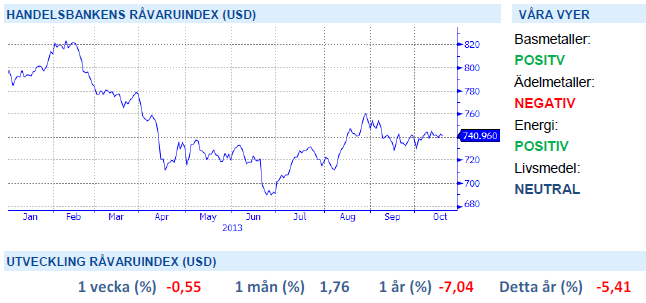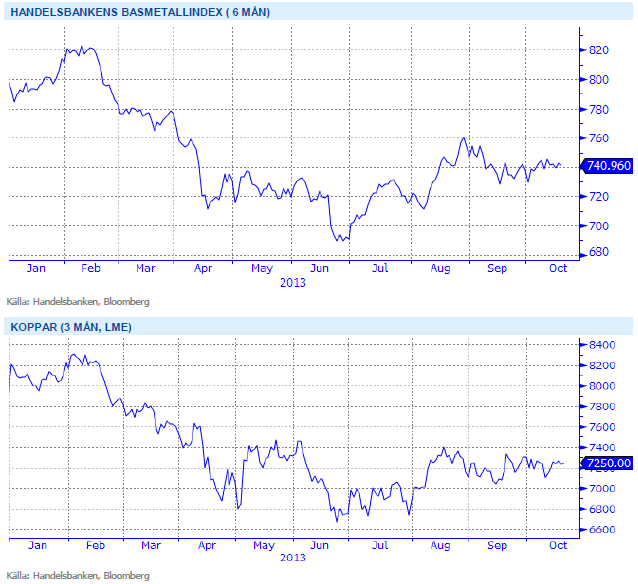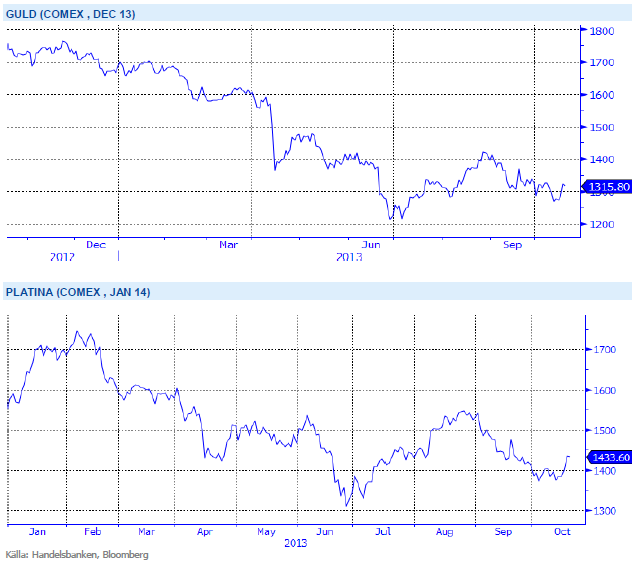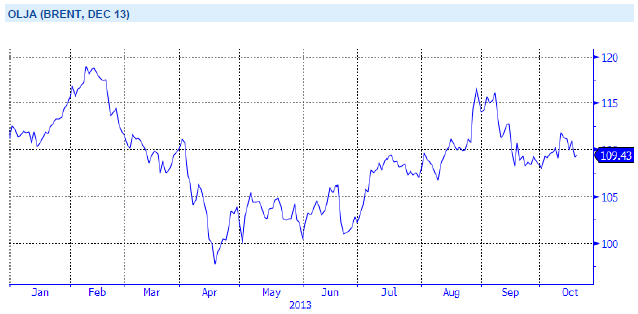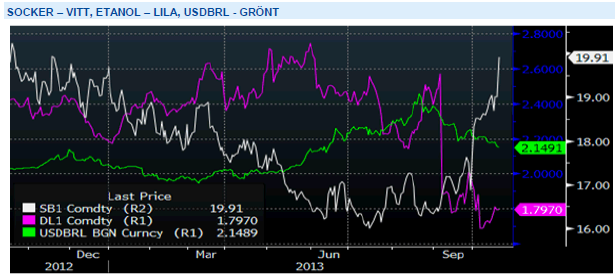Analys
SHB Råvarubrevet 18 oktober 2013

 Råvaror allmänt
Råvaror allmänt
Kinas BNP bekräftar vändning
En hörnpelare i vår tro på stigande råvarumarknad denna höst är att Kinas makro ska stå för höstens positiva överraskning och nattens BNP-siffra är ett tecken på detta, BNP-trenden i Q3 följde det sk Keqiang index uppåt, Keqiang är normaliserat mått på utlåning, järnvägstransporter och elproduktion – en bra indikator på tung industri i Kina. Kinaledningens stormöte i november är nästa större milstolpe i kommunikationen av vad som planeras kommande år. Vi tror att utvecklingen i Kina under H2 och prognoser för 2014 håller uppe kinaberoende råvaror.
Data har annars varit blandad i de stora ekonomierna på sistone. Överlag tror vi att de stora ekonomierna kommer fortsätta stärkas under de kommande månaderna då de erfar positiva efterdyningar från börsuppgångar runt om i världen. Med den akuta skuldtakskrisen i USA bakom oss så tror vi nu att marknaden kan fokusera på andra mer positiva ting. Sedan 2010 har hösten varit en stark säsong för finansiella tillgångar beroende på att det varit tiden då Fed lanserat QE stöd. Årets uteblivna nedskalning av QE är att betrakta som ett stöd och vi ser inget tecken på att höstens styrka ska brytas i år.
Basmetaller
Kina stärker metallerna
Basmetallerna har under veckan till stor del handlats på nyheter kring budgetkrisen i USA. Sedan faran (åtminstone för stunden) har blåst över kryper basmetallerna uppåt. Kinas bättre än väntad BNP-tillväxt för tredje kvartalet stärker metallerna under fredagen, 7,8 % mot väntade 7,5 %, (detta att jämföra mot andra kvartalets 7,5 %). Vi fortsätter att tro att en positiv makromiljö ska stärka basmetaller under hösten. Främst drivet av ett starkare Kina, världens största konsument av metaller.
Aluminium går dock mot trenden och backar 1,5% under veckan på plötsligt stigande lager. LME´s lager för metallen har under veckan stigit med nästan 2 %. Bly är den som sticker ut med en uppgång på över 3 %, medan övriga ligger runt 0,5 %.
Vi tror att Kinas tillväxt kommer överraska positivt under Q4 och Q1, vilket kommer stärka metallerna. Vi tror på: LONG BASMETALLER
Ädelmetaller
Korta positioner driver upp guldet
Torsdagen bjöd på ett kraftigt uppställ av guldet, drivet av att folk köpte tillbaks korta positioner. Rörelsen ser ut tappa kraft här kring 1320 dollar per uns, och vår mer negativa syn på ädelmetaller kvarstår. Under veckan som gått har hela ädelmetallsektorn stigit ganska mycket, och platina visar upp den starkaste uppgången på hela fem procent.
Vi är sedan förra veckan tillbaks i vår mer långsiktiga negativa vy på guldet, framför allt för att de faktorer som borde kunna driva upp priset kortsiktigt nu ebbat ut. När världen nu ser ut att gå in i en period av bättre tillväxt, och med ”flaskhalsar” i tillväxtekonomierna tror vi att det är rätt att favorisera konjunkturdrivna råvaror, och guldets närmast kontracykliska egenskaper kommer då att hämma prisutvecklingen.
Efter en uppgång under sommaren tror vi åter att guldets väg lutar utför. Vi tror på: SHRT GULD H
Energi
Fokus på USA
Oljemarknaden har varit väldigt stilla under veckan där det mesta av fokus riktats mot amerikanska budgetförhandlingar och diskussionerna mellan Iran, USA, Ryssland, Kina, Frankrike, UK och Tyskland där Iran antyder att man är redo att dra ned sin kärntekniska verksamhet för att lätta på de ekonomiska sanktionerna (nästa möte den 7-8 nov i Genève). Amerikansk sysselsättningsstatistik kom in något sämre än väntat och priset backar med 0.7 procent över veckan. Marknaden har fastnat i något av en range som blir snävare och snävare där vi bör se ett trendbrott snart.
Elpriset (Q114) har fallit med ca 2.5 procent under veckan efter att det lågtrycksdominerade vädret ligger kvar. Det blir mycket varmare, mer tillrinning och kärnkraften som föll ut oväntat förra veckan är på väg in igen. Även kol och utsläppsrätterna pressade något ytterligare under veckan. Energibalansen ser ut att förbättras med ca 1TWh från föregående vecka men visar fortsatt på ett underskott om 19 TWh mot normalen. Vi har varit positiva till elpriset sedan i augusti och ser detta som en fullt naturlig korrigering när energiutfallet dessutom ser ut att bli något bättre än väntat, förutsättningarna för ett stigande elpris mot vintern kvarstår dock med underskottet i balansen, marginalkostnadsstödet för kol (svårt att motivera amerikansk export om man ser till transportkostnader på uppemot 20 dollar från gruva till hamn och ytterligare en 10-11 dollar frakt till Europa…) och osäkerheten i kärnkraften.
Energiunderskott tillsammans med osäkerhet kring kärnkraftsverken inför vintern talar för högre elpris. Vi tror på: LONG EL
Livsmedel
Fortsatt blött i delar av Ryssland
Terminspriserna på vete handlas på ungefär samma nivå som för en vecka sedan i både Chicago och Paris. USA:s höstveteregioner faller en del regn, vilket gynnar redan sådd gröda. I Australien fortgår skörden med gott resultat. Argentina är fortfarande torrt och helt klart har vetet tagit skada. Det regnar dock fortfarande i stora delar av Ukraina varför en del ifrågasätter detta, det finns också stora frågetecken angående möjligheten för den sent sådda grödan att utvecklas tillräckligt väl inför vintern. Samma situation, om inte värre, råder i Ryssland där de enligt en del uppgifter haft den mest nederbördsrika septembermånaden sedan år 1885! Även där regnar det fortfarande i en del områden och kanske än mer i Ryssland ifrågasätts chanserna för den sent sådda grödan att utvecklas väl – sen sådd och blöta fält är inte idealiskt. Det finns gott om vete (och annan spannmål) att tillgå i världen, inte minst med en förväntad stor skörd i Australien på ingång – varför en eventuell fortsatt uppgång bör begränsas på kort sikt. Problemen i öst bör dock tas på allvar och följas noggrant då det kan få stora följder för nästa års produktionsnivå.
Kraftig nederbörd i Brasilien, världens topproducent av socker, försenar exporten för säsongen. Det blöta vädret har sen i mitten av juli gett stöd till sockerpriset som noteras upp 25 procent från nivåer kring produktionskostnad och står i nuläget på ett årshögsta. En starkare brasiliansk real mot dollarn är en annan orsak bakom den kraftiga uppgången. Det starka sockerpriset har således drivit med sig etanolen som har vänt upp från treårshögsta.
Försening av skörden efter längre perioder av nederbörd i Brasilien samt en stark brasiliansk real driver upp sockerpriset. Vi tror på: BULL SOCKER
Handelsbankens Råvaruindex
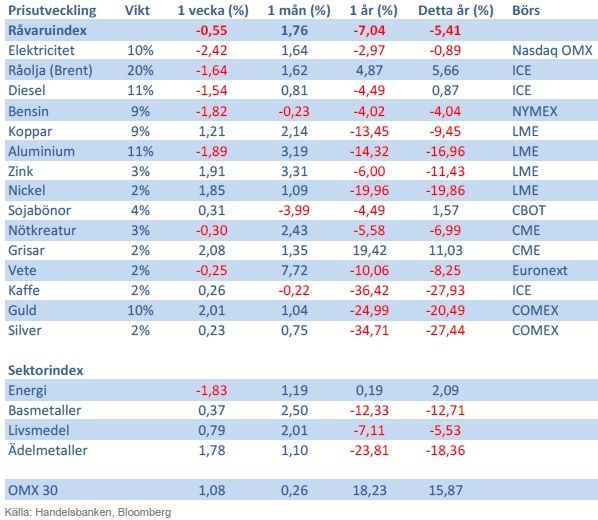
Handelsbankens råvaruindex består av de underliggande indexen för respektive råvara. Vikterna är bestämda till hälften från värdet av nordisk produktion (globala produktionen för sektorindex) och till hälften från likviditeten i terminskontrakten.
[box]SHB Råvarubrevet är producerat av Handelsbanken och publiceras i samarbete och med tillstånd på Råvarumarknaden.se[/box]
Ansvarsbegränsning
Detta material är producerat av Svenska Handelsbanken AB (publ) i fortsättningen kallad Handelsbanken. De som arbetar med innehållet är inte analytiker och materialet är inte oberoende investeringsanalys. Innehållet är uteslutande avsett för kunder i Sverige. Syftet är att ge en allmän information till Handelsbankens kunder och utgör inte ett personligt investeringsråd eller en personlig rekommendation. Informationen ska inte ensamt utgöra underlag för investeringsbeslut. Kunder bör inhämta råd från sina rådgivare och basera sina investeringsbeslut utifrån egen erfarenhet.
Informationen i materialet kan ändras och också avvika från de åsikter som uttrycks i oberoende investeringsanalyser från Handelsbanken. Informationen grundar sig på allmänt tillgänglig information och är hämtad från källor som bedöms som tillförlitliga, men riktigheten kan inte garanteras och informationen kan vara ofullständig eller nedkortad. Ingen del av förslaget får reproduceras eller distribueras till någon annan person utan att Handelsbanken dessförinnan lämnat sitt skriftliga medgivande. Handelsbanken ansvarar inte för att materialet används på ett sätt som strider mot förbudet mot vidarebefordran eller offentliggörs i strid med bankens regler.
Analys
More weakness and lower price levels ahead, but the world won’t drown in oil in 2026

Some rebound but not much. Brent crude rebounded 1.5% yesterday to $65.47/b. This morning it is inching 0.2% up to $65.6/b. The lowest close last week was on Thursday at $64.11/b.

The curve structure is almost as week as it was before the weekend. The rebound we now have gotten post the message from OPEC+ over the weekend is to a large degree a rebound along the curve rather than much strengthening at the front-end of the curve. That part of the curve structure is almost as weak as it was last Thursday.
We are still on a weakening path. The message from OPEC+ over the weekend was we are still on a weakening path with rising supply from the group. It is just not as rapidly weakening as was feared ahead of the weekend when a quota hike of 500 kb/d/mth for November was discussed.
The Brent curve is on its way to full contango with Brent dipping into the $50ies/b. Thus the ongoing weakening we have had in the crude curve since the start of the year, and especially since early June, will continue until the Brent crude oil forward curve is in full contango along with visibly rising US and OECD oil inventories. The front-month Brent contract will then flip down towards the $60/b-line and below into the $50ies/b.
At what point will OPEC+ turn to cuts? The big question then becomes: When will OPEC+ turn around to make some cuts? At what (price) point will they choose to stabilize the market? Because for sure they will. Higher oil inventories, some more shedding of drilling rigs in US shale and Brent into the 50ies somewhere is probably where the group will step in.
There is nothing we have seen from the group so far which indicates that they will close their eyes, let the world drown in oil and the oil price crash to $40/b or below.
The message from OPEC+ is also about balance and stability. The world won’t drown in oil in 2026. The message from the group as far as we manage to interpret it is twofold: 1) Taking back market share which requires a lower price for non-OPEC+ to back off a bit, and 2) Oil market stability and balance. It is not just about 1. Thus fretting about how we are all going to drown in oil in 2026 is totally off the mark by just focusing on point 1.
When to buy cal 2026? Before Christmas when Brent hits $55/b and before OPEC+ holds its last meeting of the year which is likely to be in early December.
Brent crude oil prices have rebounded a bit along the forward curve. Not much strengthening in the structure of the curve. The front-end backwardation is not much stronger today than on its weakest level so far this year which was on Thursday last week.

The front-end backwardation fell to its weakest level so far this year on Thursday last week. A slight pickup yesterday and today, but still very close to the weakest year to date. More oil from OPEC+ in the coming months and softer demand and rising inventories. We are heading for yet softer levels.

Analys
A sharp weakening at the core of the oil market: The Dubai curve

Down to the lowest since early May. Brent crude has fallen sharply the latest four days. It closed at USD 64.11/b yesterday which is the lowest since early May. It is staging a 1.3% rebound this morning along with gains in both equities and industrial metals with an added touch of support from a softer USD on top.

What stands out the most to us this week is the collapse in the Dubai one to three months time-spread.
Dubai is medium sour crude. OPEC+ is in general medium sour crude production. Asian refineries are predominantly designed to process medium sour crude. So Dubai is the real measure of the balance between OPEC+ holding back or not versus Asian oil demand for consumption and stock building.
A sharp weakening of the front-end of the Dubai curve. The front-end of the Dubai crude curve has been holding out very solidly throughout this summer while the front-end of the Brent and WTI curves have been steadily softening. But the strength in the Dubai curve in our view was carrying the crude oil market in general. A source of strength in the crude oil market. The core of the strength.
The now finally sharp decline of the front-end of the Dubai crude curve is thus a strong shift. Weakness in the Dubai crude marker is weakness in the core of the oil market. The core which has helped to hold the oil market elevated.
Facts supports the weakening. Add in facts of Iraq lifting production from Kurdistan through Turkey. Saudi Arabia lifting production to 10 mb/d in September (normal production level) and lifting exports as well as domestic demand for oil for power for air con is fading along with summer heat. Add also in counter seasonal rise in US crude and product stocks last week. US oil stocks usually decline by 1.3 mb/week this time of year. Last week they instead rose 6.4 mb/week (+7.2 mb if including SPR). Total US commercial oil stocks are now only 2.1 mb below the 2015-19 seasonal average. US oil stocks normally decline from now to Christmas. If they instead continue to rise, then it will be strongly counter seasonal rise and will create a very strong bearish pressure on oil prices.
Will OPEC+ lift its voluntary quotas by zero, 137 kb/d, 500 kb/d or 1.5 mb/d? On Sunday of course OPEC+ will decide on how much to unwind of the remaining 1.5 mb/d of voluntary quotas for November. Will it be 137 kb/d yet again as for October? Will it be 500 kb/d as was talked about earlier this week? Or will it be a full unwind in one go of 1.5 mb/d? We think most likely now it will be at least 500 kb/d and possibly a full unwind. We discussed this in a not earlier this week: ”500 kb/d of voluntary quotas in October. But a full unwind of 1.5 mb/d”
The strength in the front-end of the Dubai curve held out through summer while Brent and WTI curve structures weakened steadily. That core strength helped to keep flat crude oil prices elevated close to the 70-line. Now also the Dubai curve has given in.

Brent crude oil forward curves

Total US commercial stocks now close to normal. Counter seasonal rise last week. Rest of year?

Total US crude and product stocks on a steady trend higher.

Analys
OPEC+ will likely unwind 500 kb/d of voluntary quotas in October. But a full unwind of 1.5 mb/d in one go could be in the cards

Down to mid-60ies as Iraq lifts production while Saudi may be tired of voluntary cut frugality. The Brent December contract dropped 1.6% yesterday to USD 66.03/b. This morning it is down another 0.3% to USD 65.8/b. The drop in the price came on the back of the combined news that Iraq has resumed 190 kb/d of production in Kurdistan with exports through Turkey while OPEC+ delegates send signals that the group will unwind the remaining 1.65 mb/d (less the 137 kb/d in October) of voluntary cuts at a pace of 500 kb/d per month pace.

Signals of accelerated unwind and Iraqi increase may be connected. Russia, Kazakhstan and Iraq were main offenders versus the voluntary quotas they had agreed to follow. Russia had a production ’debt’ (cumulative overproduction versus quota) of close to 90 mb in March this year while Kazakhstan had a ’debt’ of about 60 mb and the same for Iraq. This apparently made Saudi Arabia angry this spring. Why should Saudi Arabia hold back if the other voluntary cutters were just freeriding? Thus the sudden rapid unwinding of voluntary cuts. That is at least one angle of explanations for the accelerated unwinding.
If the offenders with production debts then refrained from lifting production as the voluntary cuts were rapidly unwinded, then they could ’pay back’ their ’debts’ as they would under-produce versus the new and steadily higher quotas.
Forget about Kazakhstan. Its production was just too far above the quotas with no hope that the country would hold back production due to cross-ownership of oil assets by international oil companies. But Russia and Iraq should be able to do it.
Iraqi cumulative overproduction versus quotas could reach 85-90 mb in October. Iraq has however steadily continued to overproduce by 3-5 mb per month. In July its new and gradually higher quota came close to equal with a cumulative overproduction of only 0.6 mb that month. In August again however its production had an overshoot of 100 kb/d or 3.1 mb for the month. Its cumulative production debt had then risen to close to 80 mb. We don’t know for September yet. But looking at October we now know that its production will likely average close to 4.5 mb/d due to the revival of 190 kb/d of production in Kurdistan. Its quota however will only be 4.24 mb/d. Its overproduction in October will thus likely be around 250 kb/d above its quota with its production debt rising another 7-8 mb to a total of close to 90 mb.
Again, why should Saudi Arabia be frugal while Iraq is freeriding. Better to get rid of the voluntary quotas as quickly as possible and then start all over with clean sheets.
Unwinding the remaining 1.513 mb/d in one go in October? If OPEC+ unwinds the remaining 1.513 mb/d of voluntary cuts in one big go in October, then Iraq’s quota will be around 4.4 mb/d for October versus its likely production of close to 4.5 mb/d for the coming month..
OPEC+ should thus unwind the remaining 1.513 mb/d (1.65 – 0.137 mb/d) in one go for October in order for the quota of Iraq to be able to keep track with Iraq’s actual production increase.
October 5 will show how it plays out. But a quota unwind of at least 500 kb/d for Oct seems likely. An overall increase of at least 500 kb/d in the voluntary quota for October looks likely. But it could be the whole 1.513 mb/d in one go. If the increase in the quota is ’only’ 500 kb/d then Iraqi cumulative production will still rise by 5.7 mb to a total of 85 mb in October.
Iraqi production debt versus quotas will likely rise by 5.7 mb in October if OPEC+ only lifts the overall quota by 500 kb/d in October. Here assuming historical production debt did not rise in September. That Iraq lifts its production by 190 kb/d in October to 4.47 mb/d (August level + 190 kb/d) and that OPEC+ unwinds 500 kb/d of the remining quotas in October when they decide on this on 5 October.

-

 Nyheter4 veckor sedan
Nyheter4 veckor sedanMahvie Minerals i en guldtrend
-

 Analys4 veckor sedan
Analys4 veckor sedanVolatile but going nowhere. Brent crude circles USD 66 as market weighs surplus vs risk
-

 Nyheter4 veckor sedan
Nyheter4 veckor sedanAktier i guldbolag laggar priset på guld
-

 Nyheter3 veckor sedan
Nyheter3 veckor sedanKinas elproduktion slog nytt rekord i augusti, vilket även kolkraft gjorde
-

 Nyheter3 veckor sedan
Nyheter3 veckor sedanTyskland har så höga elpriser att företag inte har råd att använda elektricitet
-

 Nyheter4 veckor sedan
Nyheter4 veckor sedanGuld når sin högsta nivå någonsin, nu även justerat för inflation
-

 Nyheter4 veckor sedan
Nyheter4 veckor sedanDet stigande guldpriset en utmaning för smyckesköpare
-

 Analys4 veckor sedan
Analys4 veckor sedanWaiting for the surplus while we worry about Israel and Qatar


